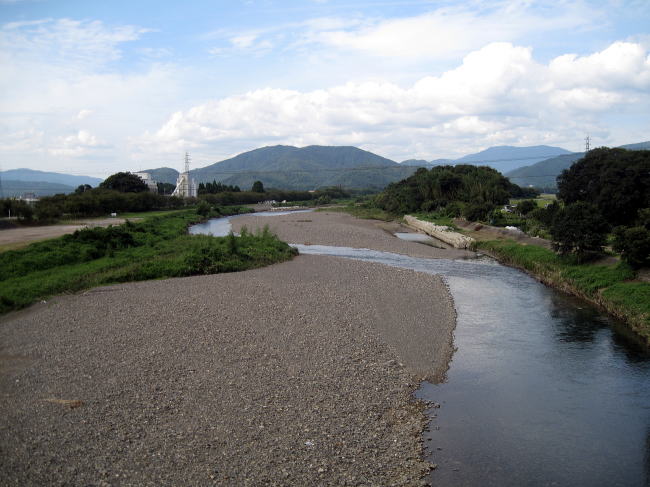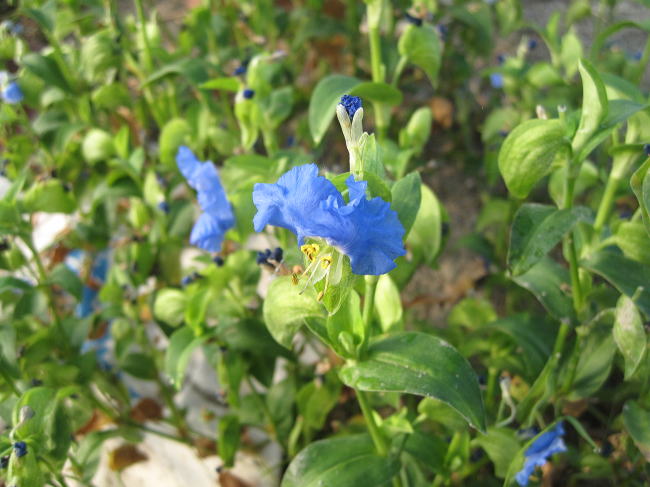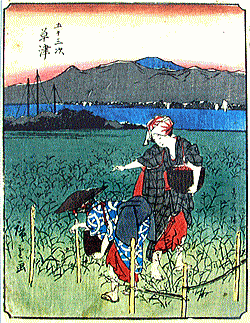Weekly Topics/Archive
September 2010
|
When I was reading the Shiga page in the morning edition of the Mainichi
Newspapers
after getting up in the morning on September 26, I found the report with
title, “The buckwheat
blossoms which stood with the heat wave this summer are at their best.”
According to the paper, the buckwheat field is located in the countryside
in Takatsuki town,
Nagahama City, where I passed on the cycling trip around Lake Biwa this
May.
I like soba noodle.
However,I've never seen the buckwheat,which is raw material for making
soba powder.
I decided to visit the field because I was tempted to look at the buckwheat,
and the
buckwheat in full bloom.
I make a decison quickly as soon as I think of the idea.
This fancy footwork may be because I'm a pensioner who has much spare time.
I took a JR special rapid train from JR Kusatsu station to JR Maibara station,
then
transferred to the JR Hokuriku Line and got off at JR Takatsuki station.
It took about an hour and a half from Kusatsu station to Takatsuki station
because I had
a bad connection to the Hokuriku Line at Maibara station.
I walked to the buckwheat field seeing a road map on sightseeing brochure.
I got at the tourist information counter at Takatsuki station.
Anyway,I used Mt.Odaniyama and the Takatoki River as rough guides.
If I walk across the bridge over the Takatoki River,I should be able to find the field
in the countryside between the river and the mountain.
It's really pastrol outside.
There isn't a soul on the village's streets.
Ocassionally,cars just pass by on the street.
I got to the Takatoki River in about 15 minutes.
 |
The view of the Takatoki River from the Amida bridge
(Takatsuki Town in Nagahama City, Shiga Prefecture) |
When I got across the Amida bridge over the river,I found a stretch of
white field on
the right side.
There stretches out that landscape in today's paper before me.
You can also see Mt.Odaniyama behind the field.
On the mountain-top,there was Odani Castle where Sengoku Daimyo,Azai Nagamasa
had lived in.
Azai Nagamasa was the father of Azai's three sisters in next year's NHK
period drama,
" Go :Hime-tachi no Sengoku".
I'm looking at the buckwheat field for the first time.
It seemed as if the field wore light make-up with snow.
|
|
|
|
|
The buckwheat field where small white blossoms were at their best
|
It wasn't only white flower that I could see.
At the side of the road along the field,not only white and red cosmoses
but also some red,
purple and yellow flowers were at their best not to be outdone by buckwheat.
After I came to Takatshki town,I knew it from the sightseeing brochure
that the town has
passed down many excellent Kannon to posterity as the Kannon village.
It's said that every village in Takatsuki town has a temple to enshrine Kannon.It's also said
that Kannon of Douganzi Temple (or Kogenzi Temple) is designated as national
treasure
and is regarded as the most beautiful one in the seven national treasure
"Zyuuichimen
Kannon" in Japan.
I can't help but visit the temple.
So I followed the "Douganzi temple" signpost and walked towards
the temple.
 |
| The first gate(i.e. sammon) of the "Douganzi temple" |
For details about "kougenzi temple", please visit the following
page.
 Picture / Pilgrimage to old temples / 「慈雲山 向願寺 (渡岸寺観音堂)」 Picture / Pilgrimage to old temples / 「慈雲山 向願寺 (渡岸寺観音堂)」
[Note] Kannon village ; 観音の里、 withstand 〜 ; (人・物が)〜(困難など)に耐える
buckwheat ; ソバ(植物)、 soba powder ; ソバ粉、 raw material ; 原料
be tempted to 〜;〜したくなる、 fancy ; 軽快な、気まぐれな、 pensioner ; 年金生活者
special rapid train;新快速列車,transfer to the 〜 line;〜線に乗り換える
sightseeing brochure ; 観光案内パンフレット、 tourist information counter ; 観光案内所
pastrol ; のどかな、田園の、 as a rough guide ; おおよその目安として、 not a soul ; 人っ子一人いない
pass by ; 通り過ぎる、 a stretch of 〜 ; 一面に広がる 〜
stretch out ; (土地・時間などが)広がる、伸びている、 mountain-top ; 山頂
period drama ; 大河ドラマ、 wear light make-up ; 薄化粧をする
at the side of the road ; 道端で、 not to be outdone by 〜 ; 〜に負けじと
pass down 〜 to posterity ; 後世に〜を伝える、 enshrine ; を祀る(祭る)
Douganzi Temple ; 渡岸寺、 Kogenzi Temple ; 向願寺
Zyuuichimen Kannon;十一面観音、 be regarded as 〜;〜とされている
can't help but do;〜せざるを得ない,signpost;道標
Japanese  Diary / No.302−2010.09.27 / 「観音さまの里でソバ満開」 Diary / No.302−2010.09.27 / 「観音さまの里でソバ満開」
Yesterday morning,I heard some noise coming from stretch of rice fields in the rear of
my house.
When I looked out the window,it turned out to be the noise from the combine
harvesting
rice, which is one of the agricultural machineries.
So,I went out to see the harvest of rice.
Depending on the rice fields, some fields have turned golden.
There might have been an influence of this season's typhoon No.9.
I saw some fallen rice in the fields.
During a harvest break,I asked a farmer about the timing to harvest rice.
The best timing is basically when two-thirds of the rice stalks turn golden
and about
two-thirds of the rice field turn golden,he answered me.
Speaking of harvest of rice,farmers in the past used to harvest rice by
hand over several
days with all their family.
It was really the hard work for them.
My mother's parents' family were rice farmers.
I remember it clearly because I've ever helped the family harvest rice
when I was young.
Today, work for harvesting rice was automated with appearance of the combine
and got
easier.
The rough rice threshed is stored in the tank inside the combine.
When the tank is full,it's transferred to waiting truck through discharger
called grain auger
like a chimney.
He said,incidentally,that the breed of rice which is harvested in this field is called
"Kinuhikari".
He also said,it was named "Kinuhikari" because it share the same
DNA as "Koshihikari"
and the surface of freshly cooked rice is shining like silk.
It's said that Kinuhikari has much rice acreage in Shiga Prefecture.
Furthermore ,it's said the rice is dried by the special crop dryer immediately
after threshing
because the rough rice contains much water.
Now,it looked like almost farmers here were the elderly.
The Ministry of Agriculture, Forestry and Fisheries of Japan has released
a 2010 census of
agriculture and forestry on September 7.
And the evening edition of the Mainichi Newspapers on the same day reported
a news brief
about that on the front page.
According to the censas, the population
engaged in agriculture in Japan declined further
and the average age of its population increased
to the age of 65.8.
I feel like I saw the actual conditions here on site.
If Japanese goverment don't implement
the measures to stop these trends in some way,
Japanese agriculture may be devastated.
When can I put newly harvested rice of
"Kinuhikari" into the rice bin in my kitchen ?
Anyway,I'm looking forward to it.
[Note] stretch of 〜 ; 一面に広がる〜、 in the rear of 〜 ; 〜の後方にネ裏側に
turn out to 〜 ; 〜であることが分かる、 combine ; コンバイン(刈り取り脱穀)
season's typhoon No.9 ; (今年の)台風9号、 harvest of rice ; 稲刈り
during a harvest break ; 収穫の合間に、 two-thirds of 〜 ; 〜の2/3
Speaking of 〜 ; 〜と言えば、 over several days ; 数日にわたって
with all one's family ; 家族総出で、家族全員で、 with appearance of 〜 ; 〜の登場(出現)と共に
rough rice;籾,thresh ; 脱穀する、 discharger ; 排出装置、 grain auger ; 穀物用オ−ガ
incidentally ; ちなみに、ついでながら、 breed ; 品種、 Kinuhikari ; きぬひかり(米の品種の一つ)
rice acreage ; 作付面積、 share the same DNA as 〜 ; 〜と同じDNAを持つ
The Ministry of Agriculture, Forestry and Fisheries of Japan ; 農林水産省
the evening edition of the Mainichi Newspapers ; 毎日新聞夕刊、 censas ; 速報値
news brief ; ニュ−ス記事、actual conditions ; 実態、 here on site;この現場で
implement the measures ; 施策を推進する、in some way ; 何とかして
devastate 〜 ; 〜を壊滅させる、 newly harvested rice;新米,rice bin;米びつ
Japanese Diary / No.295−2010.09.10 / 「稲刈り」 Diary / No.295−2010.09.10 / 「稲刈り」
The other day,I got the urge to have some fried food.
I've been a grass widower since this February and can't also cook any fried
foods.
And so,I went out to downtown Kusatsu by my precious bicycle to find a restaurant where
good fried food is served.
On Kamigasa Street,I found an izakaya with a sign saying "Izakaya
for kushikatsu and
local sake".
Kushikatsu is a Japanese-style of deep-fried kebab and can be made with
chicken, pork,
seafood, and seasonable vegetables.
I decided to go there for a drink and finish dinner too.
There were an array of bottles of shochu and local sake on the shelves
behind the cooking
area.
The sign of the izakaya was sure right.
There were three customers at the counter.
I could see right away they were local people from their talking with the
alewife.
I kept up a lively conversation with a customer next to mine, while drinking
some shochu
on the rock and cold sake with some kushikatsu as an appetizer.
 |
Aobana
(commelina communis var.hortensis) |
One of the topics of our conversation is
about " Aobana-in-Kusatsu".
It's also known as "Oobousibana" in Japanese.
I saw in public relations magazine "Kusatsu"
published by Kusatsu City that an aobana is
designated as the flower which symbolizes
Kusatsu City.
However,I've never seen any scene which
aobanas are in bloom somewhere around
the city.
So,I tweeted, "I want to look at it just once."
Then he was kind enough to draw an outline
map about how to go to the place for me.
To my great surprise,it was located in a
portion of a field surrounded by rice fields
not far away from my home.
Off course,I got up early in the next moning at his recommendation.
And I went there around 6 a.m. by my bicycle to look at aobanas.
It took about five minutes from my home to the field.
I looked like the timing was not good to come here.
 |
| Photo taken at the field of aobana in Kamigasa town on august 26,2010 |
It was late because aobanas have been already harvested.
However,there still remained several aobanas in bloom after the harvest.
I was really lucky to be able to take one look at blue,refreshingly cool
and pretty aobana
flowers.
He gave me more information about "Aobana-in-Kusatsu" ,while
drinking some alcohol
with me.
They are summarized as follows.
[1] Aobana
(1)Aobana is known scientifically as "Ooboushibana" in Japanese.
(2)It's a cultivated variety which originated from Tsuyu-kusa.
Tsuyu-kusa is known as dayflower in english.
(3)The nomenclature of Aobana is commelina communis var.hortensis,
which was named by Tomitaro Makino who was a botanist in Japan.
(4)Tsuyu-kusa is about 10 cm high, but aobana grows to about 1 m high.
(5)Both tsuyu-kusa and aobana produce dark blue flowers from late
June to late August, which are 3−5 cm wide.
(6)They begin to bloom from 5 a.m. and wilt around noon.
[2]History of Aobana
(1)Emperor Tenji foundeded Otsu-kyo (now in Otsu City, Shiga prefecture)
in the middle of the 7th century.
At that time, many people from Baekje in Korea, which was invaded by
the coaliton force of Tang and Silla, immigrated to Otsu-kyo and also
taught new continental culture.
One of them was "Tsuyu-kusa" as a stock for making dye.
(2) At the time, the nobility used to wear purple or blue kimonos.
So, petals of tsuyu-kusa was used to dye their kimonos with such colors.
It's said they begun to grow tsuyu-kusas in Kusatsu around that time.
(3)In the Edo Period, Yuzen dyeing was devised.
Aobana's characteristics of being brightly-colored and water-soluble
were thought to be best for making preparatory designs on yuzen-
dyed cloth before dying without pigments.
Because of the widespread use of yuzen-dyed fabrics, aobana came
to be grown widely in Kusatsu and the demand for aobanagami as
a specialty of Ohmi had expanded dramatically.
 |
We can see the figure growing aobana even
on the ukiyo-e printed by Utagawa Hiroshige,
ukiyo-e artist, who is famous for the block
prints with titles such as "Fifty-three Stations
of the Tokaido" and so on.
(Kusatsu on the Tokaido, ukiyo-e prints by
Hiroshige in 1852. ;Murata-ya edition)
(Nakagami collection) |
(4)During the Taisho Period and the Early Showa, the production of
aobanagami was at its best.
In Kusatsu, Aobana acreage reached about 7 hectares and the
number of the farm houses reached about 500.
The main aobana-growing areas were the former village of Yamada,
Kamigasa,Shimogasa and kikawa, in present-day Kusatsu city.
I was very surprized to hear that because such villages are located
near my home.
(5)Even after the War, the production of aobanagami continued to
sustain the local economy.
However, the demand for aobanagami dropped dramatically due to
the appearance of chemical dye and the decline of kimono culture
in high economic growth period.
Farthermore, along with agricultural modernization,
aobanas-in-kusatsu which are painful and time-consuming to grow,
have been in danger of extinction.
(6)Recently, Genziro Kusano, former professor of Osaka University of
Pharmaceutical Sciences found out aobana-in-Kusatsu contains
ingredient which inhibit glycolytic enzyme and its effect have
received a lot of attention.
As a result, aobanas-in-Kusatsu are being grown actively in Kusatsu
city again, I heard.
(7)Some brands of powder-processed tea and supplement have come
on the market.
But I don't even know if they are effective against diabetic disease.
I wish the cultivation of aobana-in-Kusatsu made a strong comeback and
it helped revitalize the area.
Our conversation was about a mere aobana,but it actually contained depthful
story
if I listen to him.
Anyway,I could understand whey aobana was desinated as the flower which
symbolizes Kusatsu City.
[Note] Aobana-in-Kusatsu ; 草津あおばな、 get the urge to do ; 〜したくなる、〜の衝動にかられる
grass widower ; 別居中の男やもめ、 one's precious bicycle ; 愛車
kebab ; トルコの野菜と肉の串焼き料理、 an array of 〜 ; ずらりと並んだ〜、 sign ; 看板
alewife ; (酒場の)おかみ、女主人、 keep up a lively conversation ; 会話が弾む
keep up ; 〜し続ける、 public relations magazine ; 広報誌、 symbolize ; 〜を象徴する
be kind enough to do 〜 ; 親切にも〜する、 an outline map of 〜 ; 〜の略図
at his recommendation ; 彼の言う通り、彼の勧めで、 a field of aobana ; あおばな畑
take one look at ; 〜を一目見る、 be summarized as follows ; 要約すると以下のようになる
depthful ; 奥の深い、 Tsuyu-kusa=dayflower (in English) ; ツユクサ
cultivated variety ; 栽培変種、 nomenclature ; 学名、 botanist ; 植物学者
Tomitaro Makino ; 牧野富太郎(植物学者)
Otsu-kyo ; 大津京 ( one of the imperial capitals of Japan )
commelina communis var.hortensis ; アオバナ(大帽子花)の学名
produce dark blue flowers ; 濃い青色の花を咲かせる、 wilt ; (草花などが)しぼむ
Emperor Tenji ; 天智天皇、 Baekje ; 百済、 Tang : 唐、 Silla ; 新羅(昔の朝鮮の一国
coalition forces ; 連合軍、 stock for 〜 ; 〜の原料、 the nobility ; 貴族
dye −with the color of 〜 ; −を〜の色でで染める、 Yuzen dyeing/yuzen-dyed fabrics
; 友禅染
devise ; 考案する、 brightly-colored ; 色鮮やかな、 water-soluble ; 水溶性の
make preparatory designs on cloth before dying ; 下絵を描く、 preparatory ; 予備の、準備の
pigment ; 色素、顔料、 Ohmi ; 近江、 widespread use of 〜 ; 〜の普及、 aobanagami ; 青花紙
figure ; 人物像、 Fifty-three Stations of the Tokaido ; 東海道五十三次、 block print
; 版画
specialty ; 特産品、 aobana acreage ; あおばな作付面積、 at one's peak ; 最盛期に、最高の状態で
painful,time-consuming ; 手間のかかる、modernization ; 近代化
be in danger of extinction ; 絶滅の危機にひんしている
Osaka University of Pharmaceutical Sciences ; 大阪薬科大学
inhibit ; (酵素や器官の働き)を(自発的に)抑える、阻害する、 ingredient ; 成分
glycolytic enzyme ; 糖分解酵素、 powder-processed ; 粉末加工の
come on the market ; 売り出される、 diabetic disease ; 糖尿病
be effective against 〜 ; 〜(病気)に効く、 make a strong comeback ; たくましく復活する
revitalize ; 活性化する
Japanese Diary / No.292−2010.08.26 / 「草津あおばな」 Diary / No.292−2010.08.26 / 「草津あおばな」
Picture  Picture / The Others / 「草津あおばな」について (2010.08.28) Picture / The Others / 「草津あおばな」について (2010.08.28)
 TOPペ−ジへ戻る TOPペ−ジへ戻る
|
|